Why isn't Raheem Sterling as good for England as he is for Man City?

With two goals in 45 international appearances, it's probably safe to say that Raheem Sterling just doesn't hit the same heights for England as he does Manchester City. Why is that?
Gareth Southgate's tactical switch against Croatia to a 4-3-3 from the much-lauded 3-5-2 was necessary for this group of England players to continue to develop and improve - and one in particular should feel the benefit of that change in shape.
If you correctly guessed that this player is Raheem Sterling, then congratulations - you've won a prize. That prize is reading on to find out why England's new formation will suit Sterling so well.
READ MORE: England fan recovering in hospital after sambuca binge
READ MORE: England fans clash with Seville riot police
READ MORE: FA condemns England supporters involved in Spain trouble
Why the 3-5-2 doesn't suit Sterling's talents
Southgate's 3-5-2 featured Sterling as a second striker behind/alongside Harry Kane, able to use his pace and cunning movement to take advantage of direct passes into space and feed off his strike partner. Kane's linkup play - in theory - would provide Sterling with a way to get into the game, working around the fairly direct passing style Southgate implemented.
Sterling was superb when playing as a 10 at Liverpool from a position just behind Luis Suarez and Daniel Sturridge. For England, his average position was usually ahead of Kane, meaning he was the focal point of long passes and that when he was able to get on the ball, his only passing options were further behind. This is England's average positions map from the win over Sweden:
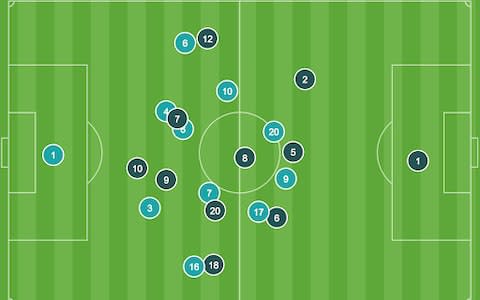
If not chasing chipped passes into the channels, Sterling's options were to either take on the defender or bide some time and then pass sideways or backwards, and while he did this relatively well, he largely performed a series of thankless tasks.
At City, Sterling is deployed on the right or left wing - the positions from which he can most easily influence the game. From here, Sterling is more readily available to receive a ball to feet and can either move inside the pitch or attack the full-back depending on the situation.
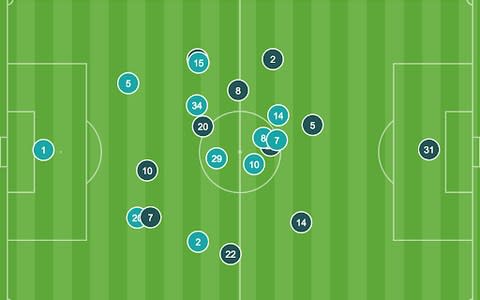
City dominate possession, England don't, and this simple fact is relevant to the shape of both teams. Kyle Walker or Benjamin Mendy regularly overlap Sterling to create width and allow him to attack central positions, which is part of the reason he is able to arrive in the right place at the right time to score tap-ins, as so many of his Man City goals seem to be. City's shape changes depending on the phase of play but there are always clear passing lanes to ensure the ball can be moved. England didn't, and likely won't, have this.
For England, Kieran Trippier and Ashley Young overlapped during the World Cup but Sterling was already in a central striker's position, marked by an opponent and less able to ghost in at the back post without a defensive minder gulping him up like Kirby. Sterling's return of four Premier League goals and two assists this season is already far more than he's managed during his entire England career... but England haven't always played a 3-5-2 - something else must be going on...
Players aren't the same
Man City are ever-so-slightly better at football than England, who don't have a single midfielder worthy of existing in the same metaphorical realm as David Silva or Kevin De Bruyne. Clearly, this makes all the difference. Without teammates creating chances to score and playing in a team which doesn't dominate possession, Sterling simply sees less of the ball and can't effect the game as much.
In seven matches during the 2018 World Cup, England created 10.14 chances to score per game, made 548.57 passes per game and took 13.42 shots per game. Eight Premier League matches into this season, Man City have created 15.25 chances per game, made 704.8 passes per game and taken 21.75 shots per game.

Sterling has had 69.63 touches of the ball per game this season for Man City and in the World Cup he had 35.5 per game. Through no fault of his own, his input to England matches has been scaring the daylights out of opposition defences and forcing them deeper than they'd like to go with his pace and movement, his presence proving as much a threat as anything he can do on the brief occasions he has found himself with possession.
At the World Cup, Sterling's output off the ball was far more valuable that anything he could do on it. For Man City he gets to face forwards rather than play with his back to goal, and is able to actually enjoy having the ball at his feet.
Not performing in an England shirt
The pressure an England shirt tends to exert on the wearer is probably relevant but Sterling, for whatever reason, seems to find himself under an awful lot of it. Media coverage of his every step (on and off the pitch) is often unfair and a little mean... but he is not immune to criticism for his work on the pitch. A big problem is that Sterling's deficiencies - namely finishing chances to score - are usually shown up most in potentially game-changing moments.
During the World Cup, Jordan Henderson liked to hit direct passes over the top of a defence for Sterling to chase. Here's an example from the Sweden game.
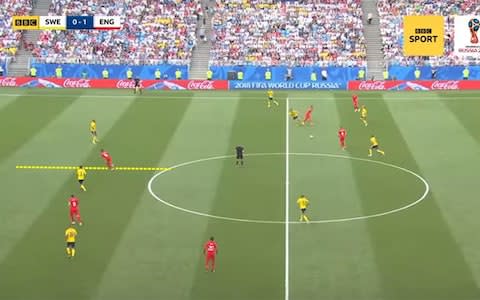
Sterling reads the play, takes off, and is in behind the back line.
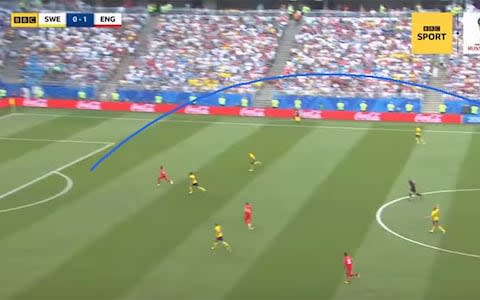
The defenders can't get close. This is where the indecision kicks in.

Sterling's first touch is brilliant, the ball is in his stride and he has control of his next step. Robin Olsen, the goalkeeper, shows him to his left...
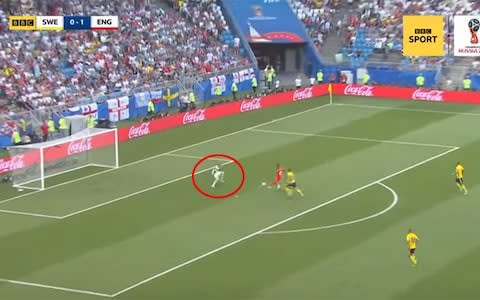
Sterling instinctively tries to round him.

Olsen saves and the chance is gone. Sterling picks up the loose ball and tries to keep the move going, passing to Kane to tee up a shot instead of making the blue arrow pass below.

This is where the panic seems to kick in. Is he overthinking things? Sterling is an instinctive player, superb at improvising and creating on the fly but whenever he is given time to calculate his angles and assess the situation, something seems to go wrong. Whether it's the final ball or the shot on goal, Sterling's last action is one of the only things that is holding him back from being considered one of the best forwards in European football.
England create so few opportunities to score that missing a single one can be the difference between a win and a draw or a draw and a defeat. Pressure builds, Sterling looks to avoid another mistake and ends up making the wrong decision. At City he tends to get at least a couple of chances for redemption during a single game.
Something isn't working for Sterling at international level but it is as much a fault of the system and circumstance as it is his unfortunate tendency to miss big chances.
If England discover the secret to incredible attacking link-play, Sterling may well discover he was wearing his goalscoring boots all along, and suddenly that incredible potential will be realised. Until that happens, it will continue to feel like Sterling is less effective for his country than his club.

